In 5 simple steps, make this heartwarming authentic vegan/vegetarian Sinigang! I grew up eating it every day, even in California's hot summers! This dish broth was made with fish, which I occasionally ate since I wasn't vegetarian. Some of the notable ingredients are kangkong, taro, and vegetarian fish/salmon.
Looking for more comfort soup? Try my Sotanghon at Upo Soup, Sour Cabbage Soup, and Vegan Misua Soup.
What is Sinigang?
Most Filipinos love sinigang stew. They cook sinigang on a daily basis. Some like pork belly, beef, fish (mostly Bangus or milkfish), shrimp, or chicken in this stew.
Filipinos love sinigang because it is so comforting to sip a bit of sour soup with all the goodness of the vegetables in it. Different regions in the Philippines have their own way of cooking sinigang and their unique way to make the soup taste sour.
Some use tamarind pulp, batuan, santol, kamias, green mango (a native fruit found in many areas of the Philippines), and calamansi as souring agent. Actually, almost all citrus fruits even lemons can be used in this delicious dish. Filipinos are creative with cooking, especially in the early times when instant sinigang mixes are not yet available.
This vegan Sinigang recipe tastes great without the fish, which I missed. A comfort food that will always be in the Philippines' top ten most popular dishes!
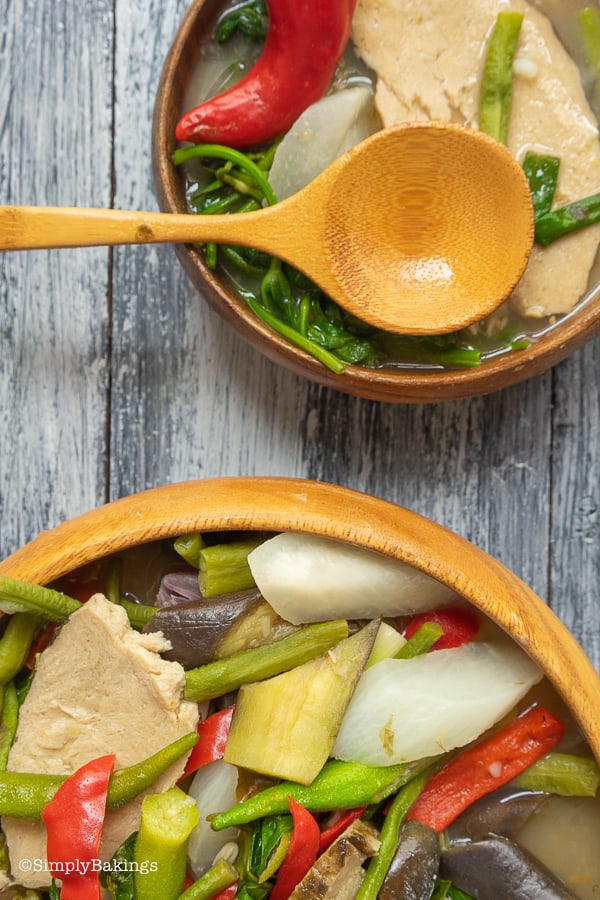
Health Benefits of Taro:
- Rich in dietary fiber for digestive health
- High in potassium, great for heart health
- Provides essential vitamins like A and C
- Contains antioxidants for overall well-being
- Supports healthy skin with vitamin E
Tips and Procedures:
- To test the doneness of the taro, poke the taro with a fork and if it's tender- it's ready.
- Always slice and prepare your vegetables ahead so that your cooking time would be stress-free.
- Slicing ahead the eggplant would its flesh brown in color. To avoid that, soak the eggplant slices in water after slicing and just take it out when you are ready to cook it.
- Do not overcook the vegetables, especially the soft ones like the kangkong. When you see that the vegetable is at its darkest or brightest color, that means it is perfectly cooked.
- If you love to add a little healthy fat to this sinigang dish, pour in some pure coconut milk and it will give your vegetarian sinigang a slightly sweet taste!
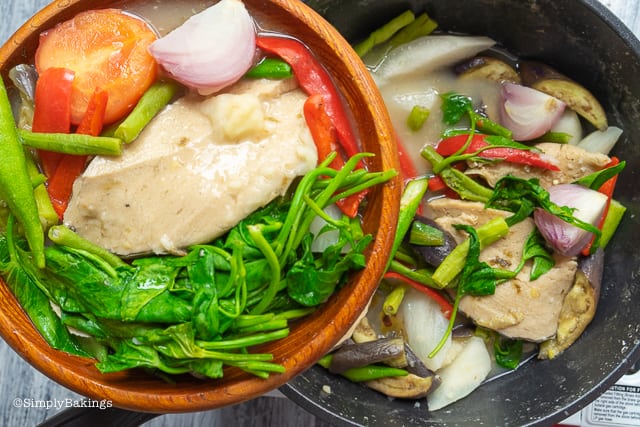
How to Make this Vegetarian Sinigang Recipe:
Gather the ingredients for this Vegetarian Sinigang and once the ingredients are all ready, let's begin!
- water
- taro, cut 1-inch cubes
- daikon radishes or labanos, sliced into 2-inch wedges
- string beans or sitaw, sliced into 3 inches
- eggplants, cut into 2-inch wedges
- batuan fruit or tamarind
- red tomato cut in half
- red onion cut in 4 pieces
- ginger, peeled and cut in halves
- bell pepper, sliced in strips
- okras
- green onions, sliced into 1-inch pieces (don’t include the roots)
- vegetarian soy salmon
- kangkong or spinach
- mushroom powder, optional
- salt & pepper to taste
In a large pot, boil 4 cups of water on medium heat. Once it’s boiling, add the taro and wait about 8-10 minutes for it to soften.:
Next, add the radish and allow it to boil for 2 more minutes. Add the string beans, eggplants and lower the heat, and cover with the lid to allow it to simmer for 2 minutes:
Next add batuan or tamarind, tomatoes, onions, bell peppers and ginger, cover with the lid and simmer for 2 more minutes:
Next, add the okra and vegetarian salmon fish and make any final seasoning adjustments with salt and black pepper or mushroom seasoning, if needed. Cover with lid for 3 minutes:
Finally, add the kangkong and green onions. This dish is best when served hot and eaten with rice (especially in the Philippines wherein every meal, there has to be rice):
There you have it! A very nutritious and vegetarian version of the authentic Filipino dish, Sinigang!
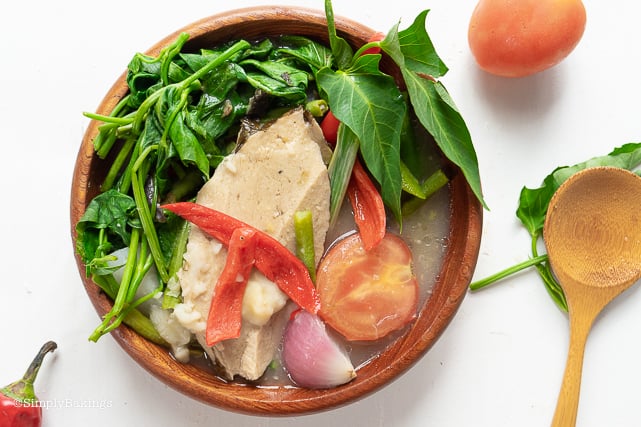
Frequently Asked Questions:
Kangkong, also known as water spinach, is a leafy green vegetable commonly used in Asian cuisines. It resembles spinach but has a milder flavor and is often used in stir-fries and soups. You can find it in Asian grocery stores or well-stocked local markets.
In a nutshell, it gives the sourness of the soup. It's difficult to find batuan in the states, but tamarind can be found at your local Asian Market. In some specialty stores, I've seen tamarind, but it's a bit more pricy.
You can find it at your local Asian market or Trader Joes.
Most Asian Markets sell them or your local grocery specialty store. I've been fortunate enough to find them easily. I live in California. 🙂
More Filipino Dishes and Desserts:
Happy Cooking!
Sinigang - Best & Delicious
Ingredients
- 4 cups of water
- 1 cup taro cut 1-inch cubes
- 2 radishes sliced into 2-inch wedges
- 3 string beans sliced into 3 inches
- 2 eggplants cut into 2-inch wedges
- 3 -4 batuan fruit or tamarind
- 2 medium-size red tomato cut in half
- 1 small red onion cut in 4 pieces
- 1- inch ginger peeled and cut in halves
- 1 large bell pepper sliced in strips
- 3 okras
- 2 pieces green onions sliced into 1-inch pieces (don’t include the roots)
- 4 pieces of vegetarian soy salmon
- 2-3 cups of kangkong or spiniach
- 1 pinch mushroom powder optional
- salt & pepper to taste
Instructions
- In a large pot, boil 4 cups of water on medium heat. Once it’s boiling, add the taro and wait about 8-10 minutes for it to soften.
- Next, add the radish and allow it to boil for 2 more minutes.
- Add the string beans, eggplants and lower the heat, and cover with the lid to allow it to simmer for 2 minutes.
- Next add batuan or tamarind, tomatoes, onions, bell peppers and ginger, cover with the lid and simmer for 2 more minutes.
- Next add the okra and vegetarian salmon fish and make any final seasoning adjustments with salt and pepper or mushroom seasoning, if needed. Cover with lid for 3 minutes.
- Finally, add the kangkong and green onions. This dish is best when served hot.
Nutrition
NEVER MISS A RECIPE!
PINTEREST / FACEBOOK / INSTAGRAM / TWITTER
If you’ve tried this or any other of my recipes, don’t forget to rate the recipe and to leave me a comment. I love hearing from you!


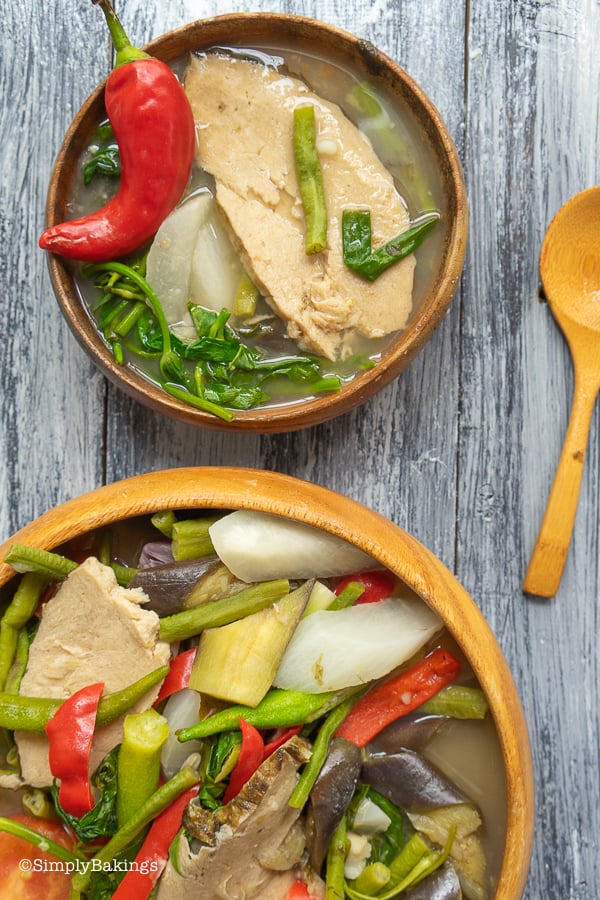

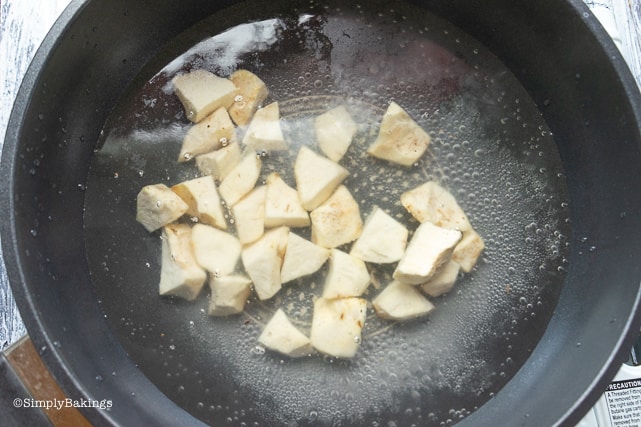
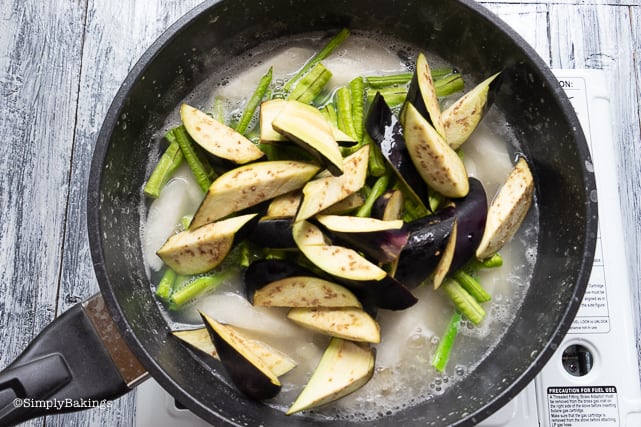
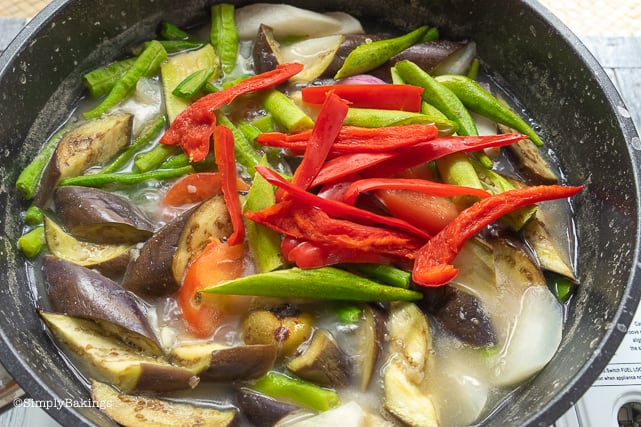
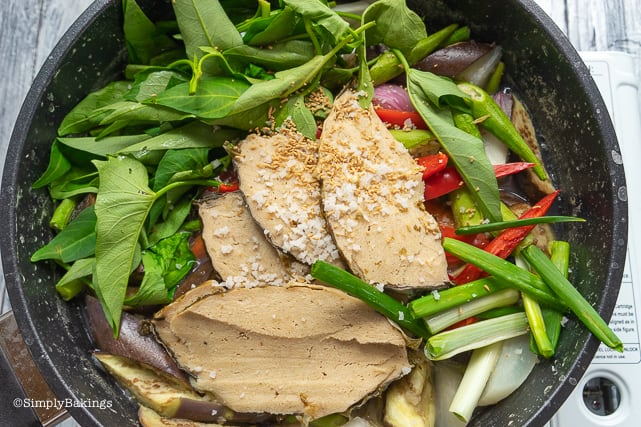
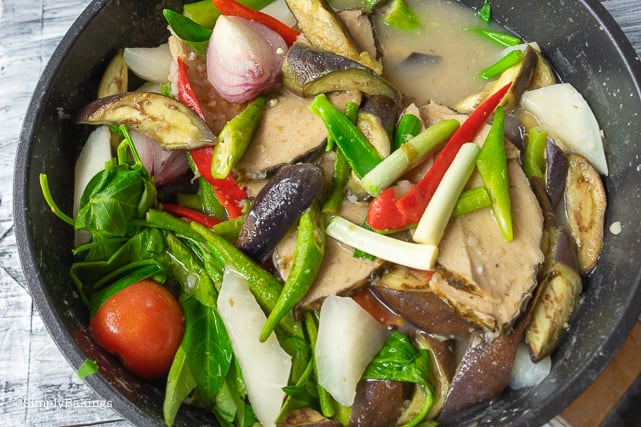
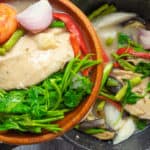

Mary S. says
Trader Joe's doesn't have pure mushroom powder, never have, hard to find, and the mushroom flavor powder they've got currently has a lot of other ingredients and a lot of added salt. Why not just suggest people find something easy like dried or fresh shiitakes. Every mushroom, even buttons and criminis, both easily available,, add umami. I've been vegetarian for 51 years and I've never heard of soy salmon, and I do shop at the local Asian and Indian markets regularly and have seen all the vegan "fish and meats" they sell. Some are actually pretty good, but they've all got additives and are expensive. Why not just suggest chick'n seitan, or firm/suoerfirm tofu, or readymade baked tofu? No one is going to find soy salmon unless they live in a place like San Francisco or NYC, somewhere huge. You can use any kind of vegan protein, or even none at all. With tomatoes and mushrooms, you've got plenty of umami, because each provides one of the two amino acids that create umami. I'd also suggest adding Better Than Buillion Sodium-Reduced Vegetable Broth paste, which keeps forever in the fridge and adds a lot of flavor to soups and stews. Don't go through the trouble of making homemade stew and then just toss in a chemical powder package or a salty broth cube! Lastly, add some soy or sodium-reduced tamari sauce, for even more umami, rather than the fish sauce which non-vegetarians add. And the flavor profile of Filipino stews often includes heat, so I add part of a sliced little hot red pepper, or some dried red bird peppers which are always easy to find at Asian and Indian grocery stores, and I always have them on hand. And I also like to add about half a daikon rather than red radishes, it adds texture and tends to soak up the broth flavor. And you can consider adding nutritional (torula) yeast for more umami flavor and body, too. It's a staple in my kitchen, just delicious, and your guests won't know how you created something so delicious and memorable. Everyone thinks "authentic" is what they ate with their families, but this recipe usually includes ginger, soy or fish sauce, sour elements like tamarind or lemon, and some source of heat. Green beans and some types of cabbage seem common, too, but I use Japanese eggplants because they're firmer with less seeds, and the skin is edible and thin, they add purple to the dish.
Lainey says
Hello, Mary! It's inspiring to know that you've been on a vegetarian diet for five decades already. I appreciate you dropping by and sharing some suggestions.
I usually encourage the readers to just feel free to make some tweaks and cook the recipes that I share according to their taste preferences. Your tips would surely help. Thank you so much, and keep sharing!